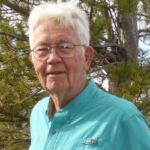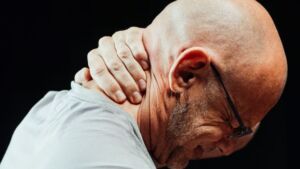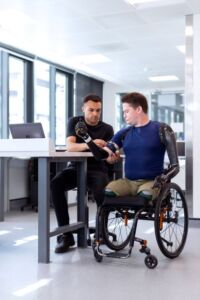by Paul Hansen, Ph.D.
 Patients occasionally appear in a psychotherapy practice who are suffering the residual effects of accidents or other body trauma that occurred in a previous period of their lives. According to medical feedback, the body has healed, or should have healed, but for some reason it has not yet released the memory of the event. Such patients typically have chronic pain or strange body reactions and are frequently referred for psychotherapy to deal with the somatic complaint. They “know” that there is something the matter with their bodies, even though most practitioners cannot find or treat the problem. It was in an effort to understand and treat this phenomenon that the technique of post-accident trauma release (ATR) was born.
Patients occasionally appear in a psychotherapy practice who are suffering the residual effects of accidents or other body trauma that occurred in a previous period of their lives. According to medical feedback, the body has healed, or should have healed, but for some reason it has not yet released the memory of the event. Such patients typically have chronic pain or strange body reactions and are frequently referred for psychotherapy to deal with the somatic complaint. They “know” that there is something the matter with their bodies, even though most practitioners cannot find or treat the problem. It was in an effort to understand and treat this phenomenon that the technique of post-accident trauma release (ATR) was born.
The ATR technique evolved three years ago after fourteen years of past-life experience. I was working with a woman under hypnosis who had been in an auto accident a year and a half prior to her first session. From the time of the accident she had been in continuous pain. In an extended session I worked intuitively to sense what would be helpful for her, and in the process an effective technique emerged. After four years of learning and experimenting I have begun to share this with others, and feedback indicates that other therapists are able to use the process with equally rewarding and exciting results.
The woman who helped this technique to evolve I’ll call Nancy. She was driving with a friend in winter over Rabbit Ears Pass in Colorado at night in a snowstorm. It is not a high pass but does get a lot of snow. Her windshield had become so clogged with snow that the wipers could not remove it, so she got out to scrape the windshield. While she was bending over the car, a truck came through the snowstorm and hit her car from behind. The impact caused her car to hit her, and she was thrown end over end through the air — “like a rag doll flying,” according to her friend — and landed on her head in a snow bank on the shoulder of the road. She was unconscious for several hours and when she regained consciousness she had little recall of the accident except for the pre-accident memory of scraping the snow and seeing the truck coming. Under hypnosis she went back through the accident several times, moment by moment, until she could recall exactly what happened — how many times her body rotated through the air, etc. She was able to remember that when her body landed, her head hit the road first, followed by her shoulder. In the process there were various points in the body that seemed to hold, some of the “shock energy.”
 The body can be conceptualized as a gelatinous mass held up by a skeletal structure. When any sort of shock impacts that mass, it does not just pass through but goes to the other side of the mass and then ricochets back and forth until gradually it dampens down and comes to a still point. It appears that wherever the kinetic energy changes direction, some of that energy is collected and held in the tissues. During our session, energy rippled again and again through Nancy’s body in a surprising way. Her whole body seemed to readjust itself as certain points were released. To understand what was going on and why the treatment was successful I began to research the field but over three years have found only beginnings of a theoretical base to understand what happened in such a transformation of bodily experience as occurred in Nancy.
The body can be conceptualized as a gelatinous mass held up by a skeletal structure. When any sort of shock impacts that mass, it does not just pass through but goes to the other side of the mass and then ricochets back and forth until gradually it dampens down and comes to a still point. It appears that wherever the kinetic energy changes direction, some of that energy is collected and held in the tissues. During our session, energy rippled again and again through Nancy’s body in a surprising way. Her whole body seemed to readjust itself as certain points were released. To understand what was going on and why the treatment was successful I began to research the field but over three years have found only beginnings of a theoretical base to understand what happened in such a transformation of bodily experience as occurred in Nancy.
In my literature search I found that in Rolfing there is often release of emotional trauma. Another lead lay in the theories of Marcel Vogel, a research scientist with IBM who developed the magnetic coating used in magnetic tapes and disks. The past few years he has been working with crystals. In the ARE convention in Phoenix in 1986 be reported that in his research he had demonstrated that body cells, bone tissue, connective and muscle tissue, even red blood cells, all store memory and information in a way that is similar to the magnetic media used in computer systems. In some of his experiments use was made of water with a minute dilution of certain salts added to store information. His conclusion was that the body stores information in areas other than the brain cells, where memory is usually considered to he located.
The following quotations reflect Vogel’s thinking:
“We store both around the body and in the various organs, particularly in the bony structure of the body, vibrations or ‘programs’ which are inharmonious to the normal process of living. These vibrations are out of place, not performing a useful function, and the body does not know how to release them. It is like a psychic or energetic cancer. As a cell which is out of place and growing on its own in a differentiating way distinct from the surrounding tissue is classified as a cancer so, too, we accumulate negative charges which disturb our pattern of living. These are parasitic. Broken bones from a fall or an injury can develop parasitic energy imbalances. After the break has healed and the tissue and bone are rebuilt, the impression of the moment of impact and the reason for the injury become stored in the area of the fracture. At that junction in the bone there is an inharmonious vibration residing. This persists, remaining with that tissue, until that area is purified from the disturbed vibration. Tissue damage and surgical intervention also create shock, which causes a state of imbalance in the area where the surgery has been performed.”
“Records are written in bone. Spinal injuries, such as whiplash, are prime areas where precise treatment can be given. A sudden impact or blow is stored in the tissue. The mind or brain has no mechanism for accessing why that injury took place and therefore cannot release that damage to the tissue. It is stuck in this area. This can be released. Bone stores the ‘program of injury’ (a holographic record of the complete experience). The bone then re-emits those signals of injury, and the surrounding tissues become ‘domain rotated.’ This means that they orient to the forces of the injury and cause a feedback circuit to develop.”
 “The body replaces its cells at least once every seven years. The small intestine is replaced every three days, with one third of it being replaced daily. Bone cells appear to take the longest to be replaced. Any site of injury within the body theoretically should be renewed with new tissue at least once in seven years. However, when there is a surgical intervention the scar may last most of a lifetime. Therefore it would seem that information is coded into the cells of that scar and its surrounding tissue that allows the scar to keep replicating itself. There seems to be some sort of change in its DNA that allows it to perpetuate itself.”
“The body replaces its cells at least once every seven years. The small intestine is replaced every three days, with one third of it being replaced daily. Bone cells appear to take the longest to be replaced. Any site of injury within the body theoretically should be renewed with new tissue at least once in seven years. However, when there is a surgical intervention the scar may last most of a lifetime. Therefore it would seem that information is coded into the cells of that scar and its surrounding tissue that allows the scar to keep replicating itself. There seems to be some sort of change in its DNA that allows it to perpetuate itself.”
Dr. Herbert Spiegel, a psychiatrist who did significant work with hypnosis in treating shell shock at the end of WW II, provided useful information. He had spent the war period in North Africa as a field surgeon treating battle wounds and later worked at the Mason General Hospital on Long Island with men who had war-associated psychiatric trauma. Since the large number of patients made analysis impractical, he developed a short cut by using hypnosis. Under trance, patients could recall what happened, and he realized that they used some sort of body phenomena, such as paralysis, blindness, amnesia, etc., to protect them from the horror of their experience. He concluded that “the memory of the event becomes linked with the horror of the event.” That is, amnesia of some sort is developed to avoid the horror. The goal of therapy in such a case is to “separate the memory from the horror so that it can be remembered without an emotional outburst, just as we can mourn the loss of a loved one without repeating our reactions at the time of the death. Memory becomes a part of the historical past without becoming a part of the hysterical present.”
In the past year I have been extending the use of ATR to past-life work in order to release past-life trauma from the body, a process which goes beyond the work of Fiore and others who merely access the trauma. ATR seems to provide additional release in the present life. An example is a man in his mid-forties who had pain in one of his ribs most of his life. He had many diagnostic workups which did not uncover anything that would explain the pain or help to treat it. Through a past-life regression he found that he had been a gold miner in California in the gold rush days. He and his friends had a gold mine in the mountains with a dam for water to use in their sluices. In the midst of a cloudburst the dam broke and caught him in a torrent. As he was drowning, one of the logs hit him in the back on one side and killed him. Apparently he carried the impression of that injury through into his present life. Release through the ATR process caused the pain to cease.
Another release was effected for a woman who died in an Indian raid on the plains as a little girl in another lifetime. In the raid the children got under the wagons for protection. Her wagon was still hitched to the horses, and in the excitement the horses pulled the wagon ahead and ran over her back so that she was trapped in great pain. She died with an Indian brave looking her in the face. With the use of ATR the chronic pain in her back was relieved.
Initially I applied the techniques of ATR to major traumas such as car accidents. However, I use it with surgeries also, and with past-life physical traumas in general. Often there is some current life trigger which assists in the initial recall of the past-life trauma or event in the manner of a computer which looks for a certain constellation of information, a pattern to recall a word or other item. Such a constellation of information in the present life can trigger past-life recall, in the manner that a fragrance or odor familiar from childhood brings memories back instantaneously.
What does the ATR process add to simple remembrance of the trauma? It is true that recall of past-life incidences facilitates healing, but the ATR process adds something significant, particularly for current life trauma. The spatial-temporal precision that the client can bring to finding the focus or locus of where the energy is trapped is surprising. Nancy could identify within an eighth of an inch where the chrome trim strip on the side of the car first hit her body, making a line across her legs. When the exact point where the energy was trapped was located in a patient who had a severe whiplash from an auto accident twenty years ago, his whole body, or the limb on which we were working, would go into a tremor. With a quarter of an inch deviation there was no response under hypnosis. The guidance of the client is essential, but an understanding of anatomy on the part of the therapist helps guide to the next point in the body where the energy might go.
John Upledger, an osteopathic physician who was on the medical school faculty at Michigan State University and who now has his own training institute in Florida, trains in cranial-sacral adjustment. At the 1980 convention of the American Holistic Medical Association I observed him working with a psychiatrist in his mid-thirties who was having extensive body problems. Through working with the fascia and tracking changes in it, he was able to track remembered events through the body, achieving some releases as he went on, until he reached the man’s left arm. There a recall was triggered of an event that had occurred when the man was two years old in which his father, in a fit of rage, had put a lock hold on the child’s arm and threatened to break it. The doctor went through a catharsis of fear from that event, accompanied by sobbing and release.
In physics there is a phenomenon known as piezoelectric. When a piece of metal is bent or an attempt is made to bend a piece of living bone, its electrical balance is changed. The compressed side becomes negative in charge and the stretched side, positive. It may be that this ionic change could also influence the “memory” of the bone, locking that event in, and may be responsible for the trauma being locked in. When a bone break occurs, there is a change in the electric balance at the bone ends, with a very slight negative ion balance at the break, which facilitates the migration of the osteoblasts to the site for bone healing.
My hypothesis about what occurs in such a phenomenon is that on a tissue level there is change in the molecular rhythm or pattern of the cell salts, which in turn is replicated when the cell divides, and this perpetuates itself. It seems to get coded into the DNA of that cell, whether it is a muscle cell, fascia, bone cell, or some other tissue of the body. Since cells are highly directed and regulated in terms of their function, although there is constant replacement, the information pattern must remain localized in the area of the injury or trauma, which is true of regular non-traumatized cells as well. If this were not so, human beings would take on some fantastic shapes, as, for instance, a thigh bone might grow where the shoulder bone belongs.
The therapeutic release, in a gross sense, reprograms the cell or cells in the area of the localized injury to re-establish its “normal” pattern. On a more specific level, the energetic change of the cell salts, which have assumed a kind of crystalline arrangement, rearrange themselves. This in turn changes the DNA, and thus the whole tissue or bone.
 The Thalamic Neuron Theory of pain mediation, an alternate theory to the Gate Pain Theory, has come out of the treatment of the injuries of Vietnam. It postulates that when a massive pain signal comes through from a nerve or group of nerves in some part of the body and passes through the thalamus, it overexcites that nerve body and leaves it permanently excited or vibrating, thus continuing to signal the brain that the indicated part of the body is still in pain. M16 bullet wounds from ‘Nam were much more likely to result in long-term pain and phantom limb pain than other wounds because the velocity and thus the impact shock of the M16 bullet is so high. This may be true even if the body part has been amputated. This theory came out of the acupuncture discipline. It was found that by re-stimulating that nerve, as by acupuncture, somewhere along the nerve chain, the neuron of the nerve is stimulated and jiggled out of its firing pattern, thus being allowed to return to normal homeostasis. There is also the theory that although the limb is not there, the etheric body is still there and is still affecting the situation. Stimulating of the acupuncture meridians also affects the body.
The Thalamic Neuron Theory of pain mediation, an alternate theory to the Gate Pain Theory, has come out of the treatment of the injuries of Vietnam. It postulates that when a massive pain signal comes through from a nerve or group of nerves in some part of the body and passes through the thalamus, it overexcites that nerve body and leaves it permanently excited or vibrating, thus continuing to signal the brain that the indicated part of the body is still in pain. M16 bullet wounds from ‘Nam were much more likely to result in long-term pain and phantom limb pain than other wounds because the velocity and thus the impact shock of the M16 bullet is so high. This may be true even if the body part has been amputated. This theory came out of the acupuncture discipline. It was found that by re-stimulating that nerve, as by acupuncture, somewhere along the nerve chain, the neuron of the nerve is stimulated and jiggled out of its firing pattern, thus being allowed to return to normal homeostasis. There is also the theory that although the limb is not there, the etheric body is still there and is still affecting the situation. Stimulating of the acupuncture meridians also affects the body.
Recently I have been studying and teaching Therapeutic Touch and doing research on it at the University of Colorado Medical Center, trying to understand what facilitates the changes that consistently occur in this modality. We have been using a sensitive device called a SQUID (Super Quantum Interference Device), in which the sensor is kept in a medium of liquid helium so that the superconductor can pick up the electromagnetic changes in the environment around the body. With this device, called a Magnetoencephalograph (MEG for short), we are able to pick up electromagnetic emanations from the body down into the pico-tesla range, which is a millionth of a billionth of a gauss (10 to the minus 15th). The average refrigerator magnet is about 30 gauss, so it is evident that this device is ultra sensitive. It is possible to get an excellent magnetocardiogram of the aura (or electromagnetic field of the body) if the device is held within a couple of inches of the chest near the heart. Accurate tracking of the electromagnetic emanations from the brain is possible as well. The ATR process may be related to these energy fields and systems.
The four steps of the process are as follows:
I. Typical Induction
- Instruct the patient to engage in abdominal breathing, taking twice as long on the exhale as the inhale in order to slow down the heart beat, lower blood pressure, and induce rapid, deep relaxation.
- Suggest a metaphoric image of turning off switches in the body to induce relaxation in adjacent muscles. Ask the patient to image the switch first, then turn it off, indicating verbally with the word “OK” when he has completed the action. Meanwhile, suggest that the body part will be relaxed, heavy, and warm. The sequence used is:
-
- right foot
- right knee
- right hip
- repeat with left foot, knee, and hip
- right hand, elbow, and shoulder
- left hand, elbow, and shoulder
- throat area—muscles of neck, shoulders, upper back
- forehead—when the switch is turned off the forehead becomes relaxed and waves of relaxation flow down until the whole face becomes heavy and warm and relaxed
- top of head, relaxing the scalp
- base of spine—suggest that the entire lower part of the body go into a deeper relaxation, giving the suggestion that as the client moves into a deeper space his awareness will become crystal clear
- top of the spine at the base of the skull suggesting that the upper part of the body is even more deeply relaxed, heavy and warm
- Repeat the long breaths to slow the heartbeat.
II. Deepening Techniques
- Invite the patient to go deeper. Ask him to imagine a vertical scale from 1-100 and ask what number he sees as approximating his level of relaxation, one being the deepest state.
- Say that you will count from ten to one and that as you do this the client will go deeper and deeper. Count slowly, interspersing the counting with suggestions for relaxation.
- Ask again about the point on the vertical scale—how far down is the client?
III. Clarifying the Accident or Trauma
- Ask the client to go back to the time when be had the accident or trauma. Say you will count from one to five, and at five he will be able to describe all the incidents. Ask for a description of physical sensations and any movement of the body. Ask for all details. During one of the repetitions, have him observe from an out-of-the-body state.
- Go back through the accident again in ultra slow motion. Go to a fraction of a moment before impact Say you will count to three and the patient will be there. Then move to the moment of impact.
IV. Trauma Release
- Say, “I will place my fingertip where you have described the impact to be.” Name this, “Help me to find the exact spot.”
- Tell the client, “We will release all pain and trauma from this place in your body. I’ll count to three. Notice where the energy goes, as it may ricochet around the body. One, two, three, release! Help me know where it went.” As you count, touch the traumatized spot very gently.
- Follow the energy to the next spot and release it in the same manner and ask the client to help you follow the energy to the next spot. Continue until all energy spots have been released.
- Instruct the client to retain the changes and suggest that the body will continue its healing process. Continue these suggestions as you count the patient back to regular consciousness.
We are still in an exploratory phase in understanding how this new process works to facilitate healing in the body, but total theoretical understanding is not necessary to be able to use the process in clinical practice.
References
Vogel, Marcel. Psychic Research: The Crystal Knowledge Workbook. San Jose, CA: Psychic Research Inc.
Connery, Donald. The Inner Source: Exploring Hypnosis With Dr. Herbert Spiegel.
Wickramasekera, Ian. “Risk Factors Leading to Chronic Stress-Related Symptoms,” in Advances, Journal of the Institute for the Advancement of Health, Vol. 4, No. 1, Spring 1987, New York.
Becker, Robert, M.D. The Body Electric. New York: William Morrow & Co., 1985.
Wolf, Fred Alan. Star Wave: Mind, Consciousness, and Quantum Physics. New York: Macmillan Publishing Co., 1984.
Sheldrake, Rupert. A New Science of Life: The Hypothesis of Formative Causation. Los Angeles: J. P. Tarcher, Inc., 1981.
